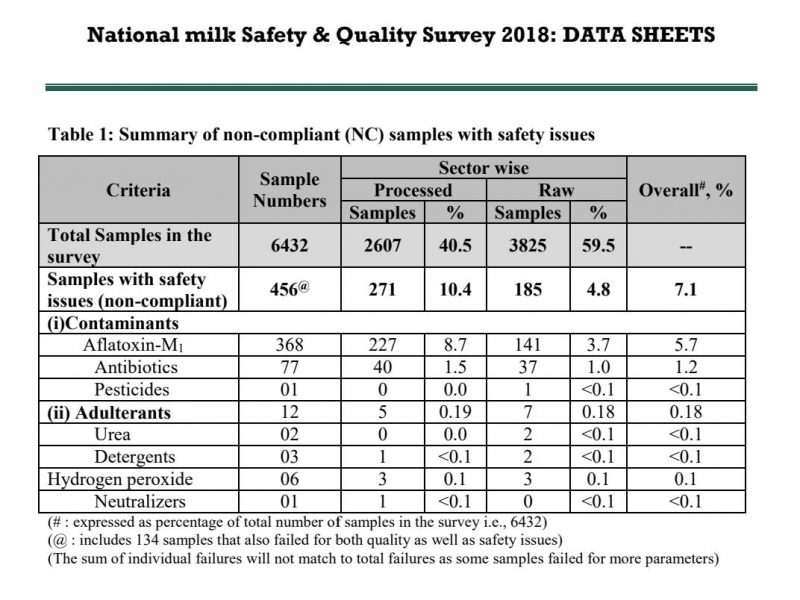How safe is the milk you drink? FSSAI survey finds startling facts
By Anusha Puppala
Highlights
- 37 percent of processed milk fails the test
- Cancer-causing aflatoxins found
- Antibiotics are also found in milk
- Adulteration is less
Hyderabad: Apart from adulteration and quality concerns, the contamination of milk due to Aflatoxin M1 and antibiotic residues is a much bigger problem in the country, reveals National Milk Safety and Quality Survey 2018. The survey report released by the Food Safety and Standards Authority of India (FSSAI) on Friday dismissed the perception of a large scale milk contamination in the country.
According to the survey, 12 out of 6,432 samples of milk were adulterated, rendering such milk unsafe for human consumption. During the study, six milk samples were found contaminated with hydrogen peroxide, three with detergents, two with urea and one sample was found to have neutralisers. No samples were found with boric acid and nitrates, the other two possible adulterants.
Out of 12 adulterated samples, nine were in Telangana, two from Madhya Pradesh and one from Kerala. While there is a concern, this also dispels a widespread perception that milk in the country is mostly adulterated. 93 per cent of samples were found to be safe for human consumption. This is undoubtedly good news for Indian consumers, says FSSAI.
Out of the 6,432 samples, Aflatoxin M1 residues were present beyond permissible limits in 368 milk samples. This was one of the significant findings during the survey as 5.7 per cent of samples had Aflatoxin M1 residues. The chemical enters the milk through feed and fodder, which are currently not regulated in the country.
Tamil Nadu has the highest levels of Aflatoxin M1 residues in their milk with 88 out of 551 samples, followed by Delhi with 38 out of 262 samples and Kerala with 37 out of 187 samples collected from their states. Aflatoxin M1 residues are present more in processed milk rather than raw milk.
According to the Food Safety and Standards Authority of India (FSSAI), this is the first time that such a detailed survey of concerning Aflatoxin M1 in milk has been conducted in India. The study, which aims to monitor the safety and quality of liquid milk in the country, was held from May 2018 to October 2018 in all states and UTs.
A total of 6,432 samples of milk were collected from 1,103 towns and cities with a population above 50,000, representing organised retailers and processors as well as local dairy farms, milk vendors and milk mandis sectors.
Out of the total samples, 77 had residues of antibiotics above the permissible limits. Amongst the top three states with highest levels of antibiotic residues are Madhya Pradesh (23 out of 335 samples), Maharashtra (nine out of 678 samples) and Uttar Pradesh (eight out of 729 samples). Only one raw milk sample in Kerala was found to contain pesticide residue above the permissible level.
After careful review of scientific opinion, the group concluded that ammonium sulphate is coming into milk naturally and is safe as it is not a contaminant as earlier thought. According to FSSAI, ammonium sulphate is allowed as an additive in certain foods in several countries.
The survey was conducted by proficient analysts in NABL-accredited and FSSAI-recognised laboratories using high-end equipment and employing established testing protocols. This survey has been carried out by an independent third-party agency. This is a first-of-its-kind extensive, well-designed, representative and most comprehensive survey to assess safety and quality of liquid milk so far.
During the survey, it was found that the level of adulterants and contaminants in failed samples is not high, therefore unlikely to pose a severe threat to human health. FSSAI says it is committed to zero tolerance for any contamination of milk. The survey also helped in the identification of hot spots, so that more intensified efforts for surveillance and enforcement could be taken up in such areas.
In a recent meeting of stakeholders, where this survey report was discussed and accepted, there was a unanimous view that the incident of spurious milk as reported in the media are one-off. They are restricted to a few areas and are seasonally occurring in festival times when there is a large demand-supply gap. Such incidents can only be tackled through a strict vigil. FSSAI has also written to the states regarding this.
While 41 per cent of samples are safe, they fall short of one or another quality parameter, the survey shows. Both raw and processed samples were found non-compliant on account of low fat or low SNF (solid, not fat) or both. The proportion of fat and SNF in milk varies widely by species and depends on breed as well.
According to the survey, non-compliance of fat and SNF in standardised/processed milk is surprising. Researches were surprised to find Maltodextrin in 156 samples and sugar in 78 samples out of 6,432 samples mainly in processed milk. Maltodextrin and sugar are not unsafe but added to raise the level of fat and SNF. While these do not represent a threat to human health, stringent action is required to curb this malpractice. Cellulose, Glucose, Starch and Vegetable oil was not found in the collected milk samples.
According to FSSAI, the outcome of the survey is a myth buster. The survey results indicate that milk being sold in India is mostly safe for consumption. More vigilant citizens and enforcement machinery are required to fight against adulteration.
